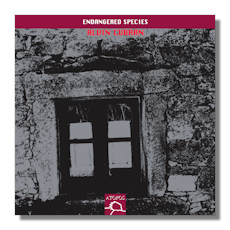
The Internet's Premier Classical Music Source
Related Links
- Latest Reviews
- More Reviews
-
By Composer
-
Collections
DVD & Blu-ray
Books
Concert Reviews
Articles/Interviews
Software
Audio
Search Amazon
Recommended Links
Site News
 CD Review
CD Review
Alvin Curran

Endangered Species
- Sample 1
- Sample 2
- Sample 3
- Sample 4
Alvin Curran, realization, "keyboard"
Atopos ATP015
Alvin Curran was born in Providence, Rhode Island in 1938 and became a pupil of Elliott Carter. Until 2006, he was professor of music at Mills College in California and now teaches privately in Rome. His musical output is considerable. Endangered Species in a way is the product of over 40 years in that it's a collection of sounds crafted into an amazingly varied and striking collage. To quote from his note in the booklet that comes with this CD, it's "…a space, a container which holds my sound archive in little vials of distilled essences. An archive of distillations culled from years of listening to everything from the mumbled sounds in dreams to threatening roars of nature gone mad, from the near absolute stillness of an Italian Ferragosto to the din accompanying a Balinese funeral, Cicadas having sex to mating BISons, human howling wolfmen, broken fog-horns, Meuzzin calling from Mosques. A life, my life and yours – of listening to the contours, textures, densities and durations of every imaginable audible thing on this planet – hearing it as one incomprehensible infinite musical work, predictable as it is unpredictable, loving as it is imminently dangerous, blind deaf indifferent and visionary at the same time." Although "every imaginable audible thing on this planet" is an exaggeration, there certainly is an immense variety in the piece.
The musicality consists not only in the initial selection, in the length of time which each component lasts, but emphatically in the sequence and progressions of sounds, merges, (cross)fades, overlays and juxtapositions. Although there are times when Endangered Species is redolent of some of Stockhausen's denser musical and electronic collages, there is a greater clarity – indeed, transparency – to this assemblage by Curran. Whereas Stockhausen and others exploring Musique Concrète issue (or issued) certain challenges, Curran seems content both with what he has produced, and with any reaction you may have. The resulting effect is twofold: on the one hand, the listener is freer from the pressure of having to "understand" each element and group of elements. On the other we listen more carefully, savoring each region of sound for what it is.
The confidence (and fact that this is the outcome of such a long "gestation" period) which Curran brings to the compilation of Endangered Species means that it's also possible not to feel obliged to look behind the music and sound. It's possible, permissible, and even easy, to listen to it on its own terms. The words "vial" and "essence" are important. Although, of course, lacking a formal structure in the conventional sense of the word, the piece does manage to convince us that what we're listening to has been painstakingly sifted from many more possible sources.
The sounds were electronically mapped onto a standard 88-key MIDI keyboard in such a way that they were invoked by playing keys – each triggering a new passage. It was clearly important to Curran that he have the sounds which we hear on the CD both immediate enough for him to "play" at will; that they encompass the huge array of sonic experience that they do; that they have a personal relevance to him; and that he had sufficient control over them and how they were "played" for a coherent narrative to result. Or, as he says in his introduction, "The Endangered Species are stories told in a language I have invented about people, places, songs, things, events, machines, musics, animals, rooms, skies, airs and dreams…each performance is a new story told with the same old sounds, thrown like a muralist painting "al fresco" newly configured each time and in each moment with the unknowable duration of one's own creative energy. As if, in fact, I were simply telling my own story, with the sounds of its worn pages, or our story with its endless cycles of sadness and joy and its inexorable pursuit of unity."
This seems at once a quite modest aim (he has control over what's included and how); and a more ambitious one (why each item is included). It's in the confluence of those two aspects of the music that its success (or failure) lies. The acid test is really whether or not that confluence (how which sounds are assembled) will prompt you to listen again and again. The first few times for curiosity, for sure. But after that, are there favorite passages? Annoying ones? Do the intervening parts later yield something that was missed earlier? Are the layers implied by such a mode of listening rich and deep, enough for repeated listening and appreciation? The hope is surely that whatever structure with which Curran has infused the piece, and on which he has built it, becomes more and more apparent and takes on a life of its own. The answers to these questions will depend to some extent on your temperament and openness to the novelty of Endangered Species. The production is well-executed enough to make it worth the effort.
Copyright © 2011, Mark Sealey.












